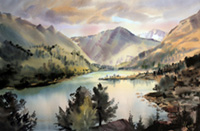Learn
Answer the Unit 3 notes as you review the lesson.
 Romanticism is a change that happened in art, literature, and music during the 19th century.
Romanticism is a change that happened in art, literature, and music during the 19th century.
There are five distinct ways that Romanticism is described: imagination, intuition, idealism, inspiration, and individuality.
Imagination:
What do you use when you apply your imagination? Yes, you use your mind. Most individuals didn't have a willingness to fail. They saw the imagination as a possible failure in their life because it takes them out of their comfort zone. However, imagination was considered necessary for creating art. Imagination and emotion are more important than reason and formal rules. Imagination is the doorway to ultimate understanding and truth. As Rene' Descartes said, "I think; therefore, I am."
Intuition:
Intuition is a certain feeling or instinct. Romantics believed that knowledge is gained through intuition rather than reasoning. William Wordsworth said that "all good poetry is the spontaneous overflow of powerful feelings." There is a reliance on natural feelings. Romantic literature emphasizes a love of nature.
Idealism:
Some people believe idealism is impracticality. Idealism is the concept that the world can be a better place through the spirit and the mind. Romantics believed in the natural goodness of humans. They believed that the savage is noble, childhood is good, and the emotions inspired by both beliefs cause the heart to soar.
Inspiration:
Art should be spontaneous rather than precise. Nature presented itself as a work of art. It could be joyful and peaceful or frightening and worrisome. Emotions and passion are inspiration to the creator because human experience gives people the freedom of through and expression.
Individuality:
Romantics celebrated the individual. Individuals have unique and endless potential. The Romantic hero embodies bravery, strength, and chivalry. Birth and class are unimportant because the individual transcends in society. He may be brooding and dark; not interested in authority, a nonconformist. He may be young and innocent, but he also has a knowledge of people and of life based on intuition.
Before you read the poem, think about the poem's title. Often times authors hide meaning and/or give clues in the title.
Also, don't overlook the literal meaning of the poem. One of the biggest problems that students often make in poetry analysis is jumping to conclusions before understanding what is taking place in the poem.
When you paraphrase a poem, write in your own words exactly what happens in the poem. Look at the number of sentences in the poem - your paraphrase should have around the same number. This technique is especially helpful for poems written in the 17th and 19th centuries.
Connotation refers to any and all poetic devices, focusing on how these devices contribute to the meaning and effect of the poem. Look for devices such as imagery, figures of speech (simile, metaphor, personification, symbolism, etc.), diction, point of view, and sound devices (alliteration, onomatopoeia, rhythm, and rhyme). You do not have to identify all the poetic devices within the poem. The ones you do identify should be seen as a way of supporting the conclusions you are going to draw about the poem.
After you have examined the poem's literary devices, look at diction (word choice), images, and details that suggest the speaker's attitude or tone. You may refer to this Tone Vocabulary List for help.
A poem usually does not begin and end in the same place. Watch for the following keys to shifts:
- key words (but, yet, however, although),
- punctuation (dashes, periods, colons, ellipsis),
- stanza divisions,
- changes in line or stanza length or both,
- irony,
- changes in sound that may indicate changes in meaning, or
- changes in diction.
Now, look at the title again, but this time a little differently. What new insight does the title provide in understanding the poem?
What is the poem saying about the human experience, motivation, or condition? What subject or subjects does the poem address? What do you learn about those subjects?
What idea does the poet what you to take away with you concerning these subjects?
Remember that the theme of any work of literature is stated in a complete sentence. It is the message that the author is sending to his audience.
You have just gone through the TP-CASTT method for analyzing poetry.
Title
Paraphrase
Connotation
Attitude
Shifts
Title
Theme
Read William Wordsworth's poem "The World Is Too Much With Us."